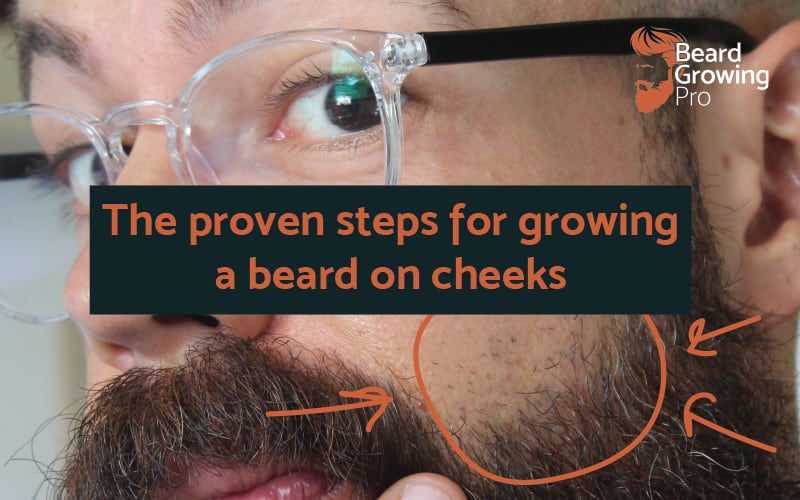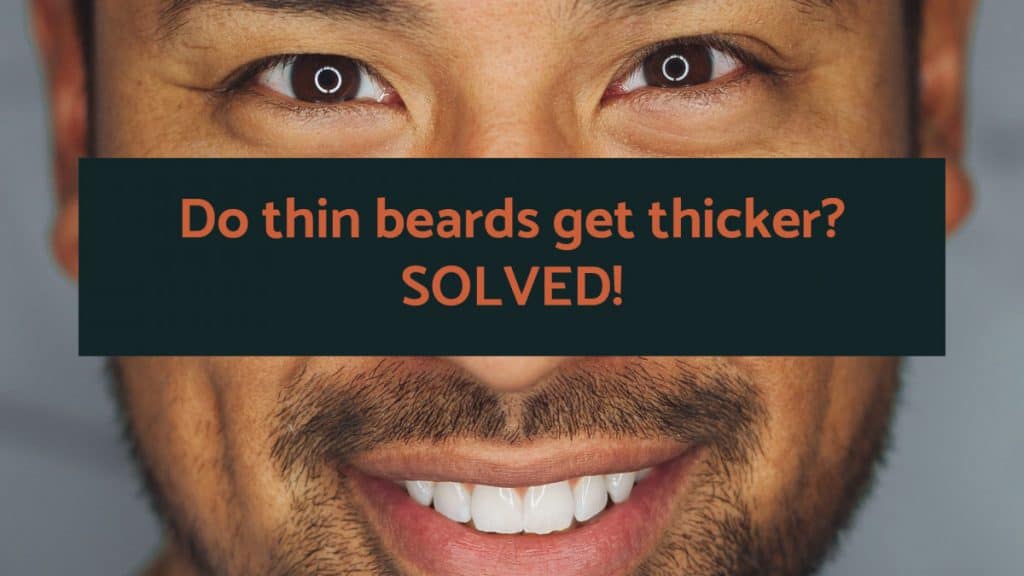When planning your beard and what you want it to look like – most people imagine a thick, luxurious beard covering their face from cheek to neck. But there’s one thing that many men face when they come to grow their beards – thin or patchy areas on their cheeks. Here we will go through the options available for growing a beard on your cheeks.
Growing beard hair on cheeks involves waiting for 12 weeks before deciding you need an intervention. Choosing a beard with a lower cheek line height and improving exercise, diet, and sleep routines to boost testosterone levels.
Despite what other blogs may tell you, there is no magic pill or cure for your hair growth.
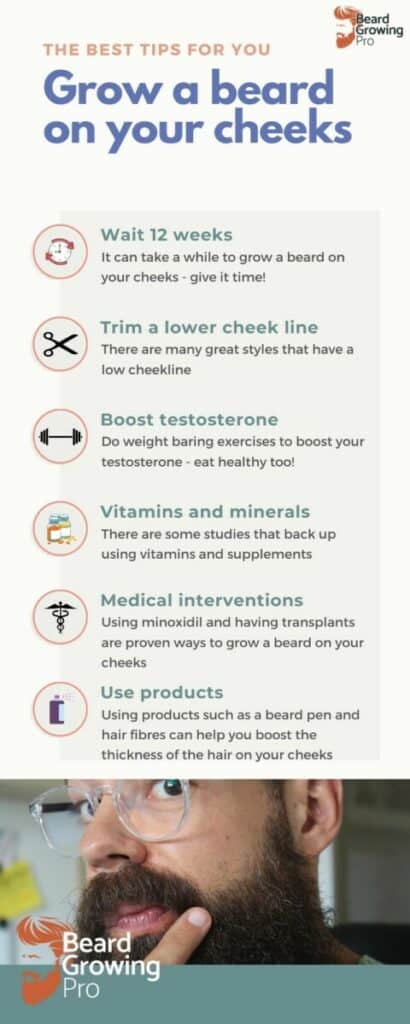
Many people have successfully used minoxidil to boost hair growth on their faces. Keep reading if you are interested in medical interventions for beard growth. I share with you the proven ways to grow a beard.
I do not, however, think that medical intervention is the right course of action for most people. At least not when they are starting their beard growing journey.
There are many other options for people who want to look good and can not grow dense hair on their cheeks that is not as expensive and risks many side effects.
Let’s take a look at the best advice for those with low-density coverage on their cheeks.
Article Contents
Rule 1: Wait for 12 weeks before deciding that you need an intervention
Many people don’t understand that you inherit a huge portion of your beard growing potential from your parents. Genetics play a huge role in determining if you can grow a beard on your cheeks.
You may have inherited sparse or fine beard hair from your ancestors. That makes you unlucky, but there’s no reason that you can’t make the most of your situation!
If you can’t grow a beard, check out our blog that goes through your options. Click here!
Every person’s hair growth rate differs, with some growing hair slower than others. Before you decide that you need an intervention for your cheek hair, you must wait at least 12 weeks. Only then will you get to know the true and underlying reasons the hair is not growing on your cheeks.
Waiting for your beard to grow can be a huge pain in the arse. Check out the stages of beard growth in my blog post here. But do not forget that the best things in life you need to wait for!
My experience growing a beard on my cheeks
It took my beard about six weeks to feel full on the cheeks, and I consider myself a good beard grower.
Even now, my beard is thinner on the cheeks than it is on my moustache and chin. I’ve come to accept that this is how my beard grows and what makes my beard unique.
If after 12 weeks you are still not happy with how your beard hairs are growing on your cheeks, you have a few options. I’ve listed them in the order that you should consider implementing them.
Saving the riskiest until last!
2. Trim a lower cheek line
As crude as this may sound, simply cutting off the problem areas is a genuinely useful tactic. It draws attention away from your problem areas and highlights the strong parts of your beard!
There is a range of style options for your beard, and although it may not be the full beard style that you were dreaming of – there are plenty of actors and fashionistas with these styles of beard!











Beard styles with a low cheek line
There are a few beard options with no cheek hair and some with a low cheek line – don’t believe me that they can look good? Check out these styles:
Balbo Beard Style

This style is characterised by the absence of hair on the cheeks. However, it gives the effect of a full beard by having long hair along the jawline. Having a strong moustache also really helps with pulling off this style!
Detached Goatee

In this image, you can see that the cheeks are very short in length and do not contribute much to the beard. It would help if you grew out the soul patch and moustache to pull this one off while keeping the length on the sides low.
Patchy beard

Patchy is normally something that we want to avoid. It’s seen as bad. But this is not always the case. Check out the beard on the man above.
The cheek area is the weakest part of his growth.
Here, it’s all about the symmetry and strong use of hair that makes this look trendy. Maybe your weak cheek line can become an asset for you! By maintaining this over a long period, you can rock some attractive facial hair while waiting for a complete beard to grow!
The Classic Goatee

If you have doubts about the hair quality on your cheeks, you can always remove the need for the hair on your cheeks completely!
Styles like the classic goatee are a strong choice if you have no other options but still want to rock some facial hair!
3. Boost testosterone levels
Next, before going for anything extreme like medication or surgery, you can try to boost the testosterone level in your body by natural means.
The more testosterone in your body, the more facial hair is stimulated to grow. Check out my blog, where this is explained in much more detail – click here.

Exercise
There’s a whole heap of research that shows that exercise is one way that you can get your testosterone levels up! Not all exercise is created equally, however. Make sure your exercise contains these activities:
- Sprinting – Studies showed that testosterone levels increased significantly for people who performed a series of very short (but intense) 6-second sprints. The testosterone levels remained high even after the participants recovered from the sprint workout.
- Lift Heavy Stuff – Studies have shown that it takes lifting heavy weights to boost testosterone levels. Focus on full-body exercises like squats, deadlifts, benchpresses and free weights at 85 – 95 % of your one-rep max!
- Use Long Rest Periods – Longer rest periods (more than 120 seconds) between reps are better than shorter rest periods.
- Remember to use your legs – Nothing feels more ‘manly’ than doing upper body exercises, like bicep curls or bench presses. Still, studies have shown significant increases in testosterone when leg and lower body exercises are included in the routine.
Try this as a workout:
- Warm-up
- Four sets of eight reps bench press with the same squats between the benchpress.
- Four sets of eight reps deadlifts with the same pull-ups in between.
- Five sets of maximum 10-second sprints
- Cool-down
Do this three days per week, and you should notice an increase in your overall health and testosterone!
Diet
Combining your exercise with a diet that will promote testosterone production in your body can help grow your beard.
- Ginger – A 2012 study showed that taking a daily ginger supplement for three months increased testosterone levels by 17.7 per cent.
- Pomegranates – Another study showed that drinking pomegranate juice for 14 days increased the testosterone found in their saliva by 24 per cent.
- Fortified plant milk – Vitamin D found in plant milk such as almonds, soy, hemp, and flax can increase testosterone levels. You can also get a great boost of vitamin D from the sun! So remember to get out and about!
- Leafy green vegetables – Leafy greens are full of magnesium – which is an element that has been shown to increase the levels of testosterone in the human body. Eat lots of spinach, kale and swiss chard!
- Tuna – An animal-based study showed that fish oil could increase testosterone levels. Because this has not been done in humans, you need to take this with a grain of salt!
Here are some other foods that will help you grow a beard – from my YouTube channel.
4. Vitamins and suppliments
Check out my full blog on vitamins and supplements for beard growth – click here.

Medication is an option that you should leave for the last resort. There can be a significant expense for the stuff that works, and there are plenty of other options that will not work and still cost a load of money!
- Boron – A couple of studies show that boron increases the testosterone and DHT levels found in the body. In one study, people were asked to take 10 mg of boron every day, and after seven days, the results were very encouraging.
- Mucuna Pruriens – There have been two studies that show the testosterone boosting power of this supplement. It has been shown that it increases testosterone levels by about 38 percent.
- Creatine – There are plenty of scientific reports that show how well creatine boosts testosterone levels in the human body.
- Ashwagandha aka Ayurveda – Two studies (here and here) used human participants, with both using 5g per day of ashwagandha root powder for 90 days. Both studies found significant increases in testosterone – about 40% and 16% on infertile subjects and about 15% in people with no fertility issues.
5. Medical interventions
medical intervention isn’t something that you should take lightly. Some people are comfortable using a topical medicinal treatment, whilst others are happy to pursue surgical intervention.
I have looked at a range of different options for growing a beard on the cheeks, and minoxidil and beard transplant seems to be the most successful and reproducible way of growing a beard on your cheeks.
Here is a rundown on both options.
Minoxidil
In the 1970s, minoxidil was introduced as an oral medication to treat hypertension. Doctors noticed hair regrowth in balding patients at the same period, leading to a topical formulation for addressing male pattern baldness in men and eventually females.
A 2% minoxidil solution was first introduced to the market in 1986, followed by a 5% formulation in 1993. It has remained an effective topical therapy for a variety of hair-related issues.
Minoxidil is a very well hair growth therapy. Rogaine and other hair regrowth products contain it. Because minoxidil is not approved for use on the face by the FDA, all of the directions are for the scalp.
One of the problems is that the hairs stop growing if you stop using a Minoxidil-based product. So, before you start using this feature, you should be informed of the potential cost and time commitment.
You may have some adverse effects, in addition to the fact that you will need to continue this treatment for a long time – up to a year and a half.
The minoxidil science
Topical minoxidil has been shown to help grow beards on men more than a placebo. The data is reported in a study published in the Japanese dermatological Association Journal in 2016. Patients were told to rub an ointment on their chin with 0.5 mL of 3 per cent minoxidil twice a day.
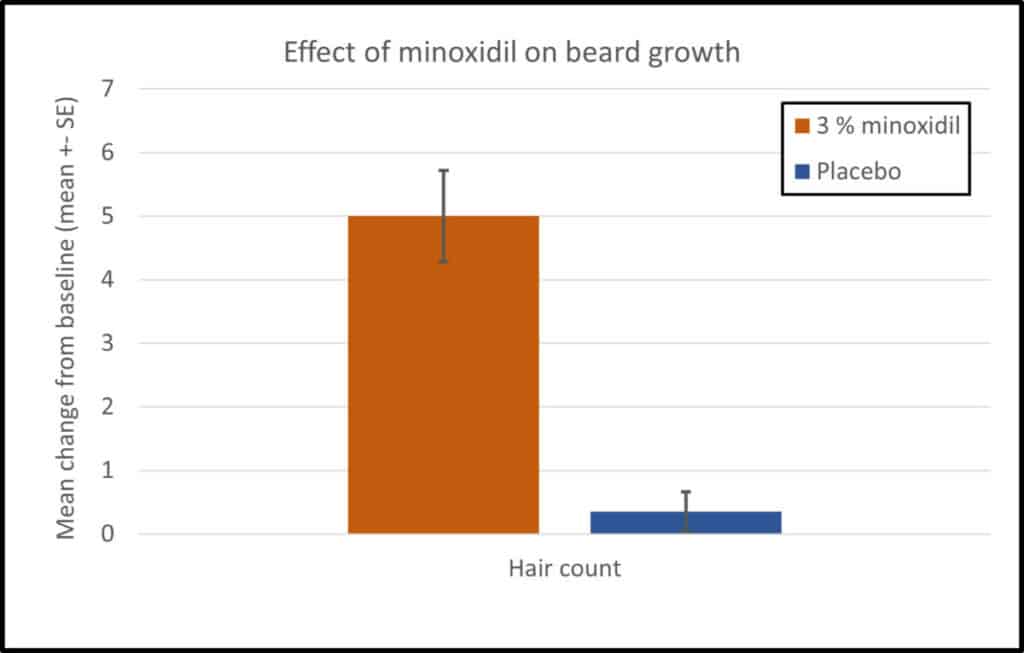
Every four weeks, the patients’ beards were photographed. Three doctors rated the photos on a seven-point scale, allowing them to calculate each individual’s various levels of beard growth. On the 16th week, patients self-assessed the growth of their beards using the same scale as a comparison.
At week 16, the minoxidil group’s photographic score was significantly greater than the placebo group’s. The topical treatment’s side effects were minor and did not differ significantly between the groups. Surprisingly, there was no statistically significant difference in hair diameter between the minoxidil and placebo groups compared to the baseline hairs.
Minoxidil has been shown to deliver amazing advantages to patients with various hair-related problems, even though it has been used for treating hair loss for a long time. Even though topical minoxidil treatment is considered an effective and safe alternative for various patients, there are many off-label uses for minoxidil that the FDA has yet to improve.
Beard transplants
Every bearded man wishes for a fuller, thicker beard, but undergoing surgery sounds a bit extreme for various reasons. Specifically, the dangers that come with any surgical operation.
This isn’t to say that people don’t want it, and according to a 2013 study, facial hair can be transplanted utilising a technique known as follicular unit grafting.
The researchers focused on the transplantation of eyebrows, goatees, moustaches, and beards. The following are the study’s main findings:
- The surgeon must ensure that the recipient sites are positioned at the shallowest angle possible to the face to achieve the greatest results.
- There is a danger zone where pimples can occur on occasion. It’s in the centre vertical column that runs from the lower lip to the chin. Hairs transplanted in this area might occasionally cause bumps.
According to the report, many males like a strong beard and moustache. They desire big sideburns to compliment their hairstyle.
The common number of grafting sites required for different areas of the body are:
- goatee – 300 to 400 grafts
- sideburns – 250 to 300 grafts
- moustache – 300 to 400 grafts
- moustache and full goatee – 850 grafts
- cheek beard – 500 grafts per cheek.
Here are the before and after results from someone who underwent this surgery.
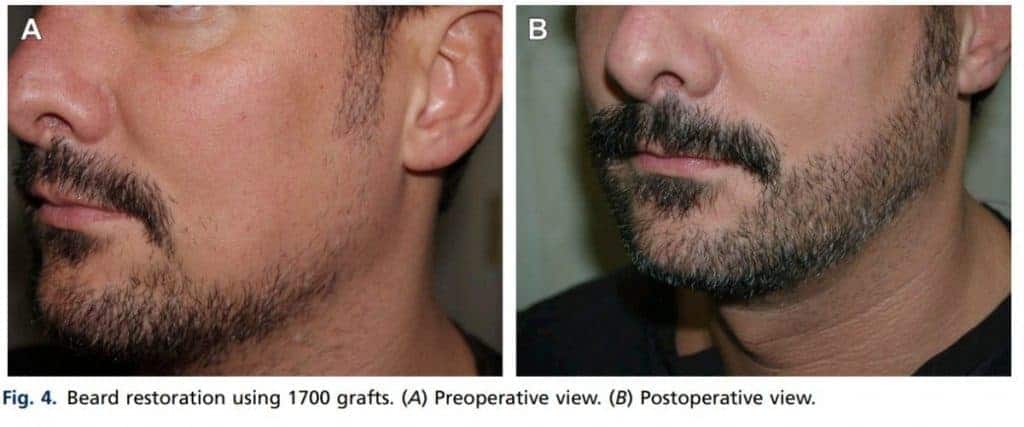
The transplanted beard appears to be quite natural. The surgeon dictates the success of the surgery, and the main thing is to find a clinic with a high reputation and a track record of success in the level of beard transplantation that you desire.
For more information on the proven ways to grow a beard, check out the science I present in my YouTube video below.
6. Products
The last option for you to thicken up the growth on your cheeks is to use products such as hair fibres and beard pens to support and exaggerate the growth that you have already been able to achieve.
Toppik hair fibres
Hair building fibres can be applied with a spray applicator attachment or by shaking the hairs over the surface of the beard. Shaking the hair building fibres will give you more coverage over a larger area, but the applicator attachment will provide a more exact application. The applicator merely delivers the fibres with a puff of air.
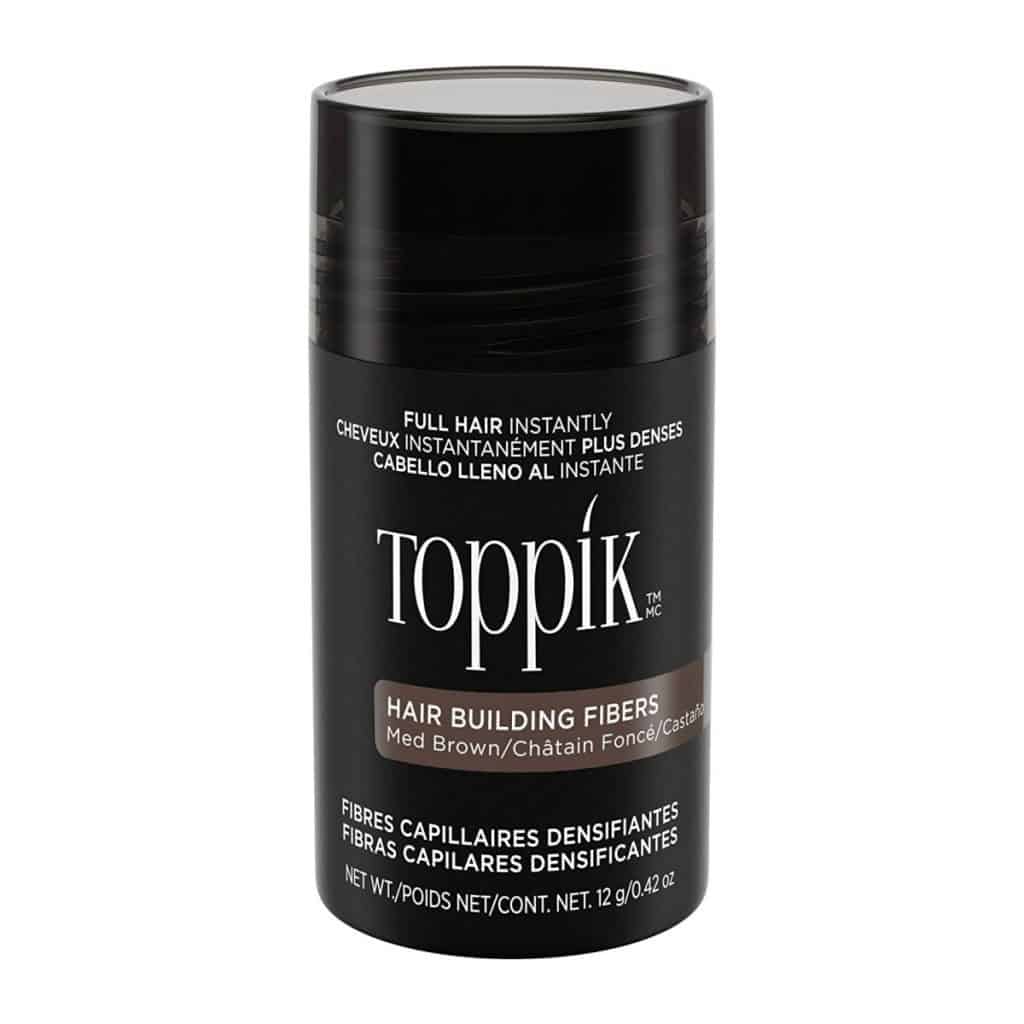
To use this beard thickening product, follow these instructions:
- Dry and style your hair as usual – hair fibres use static to adhere to the hair; therefore, the hair should be as dry as possible for efficient static attraction.
- Shake the hair fibres over the area where you desire darker results or apply them with the applicator.
- Some products include a hairline optimiser that may be put into the beard’s edges for a more natural look.
- Gently pat the hair to distribute the hair fibres and prevent any clumps from forming.
- Consider applying a fibre hold spray designed to strengthen the bond between your hair and the hair-building fibres.
The final word
If you are struggling to grow a beard on your cheeks, remember that you have plenty of options. Don’t be disheartened if you are one of the people who cannot grow any hair on their cheeks. You can adapt styles that hide the fact that your growth is weaker.
Please do not jump on the medication bandwagon before you have tried a few less invasive options!

